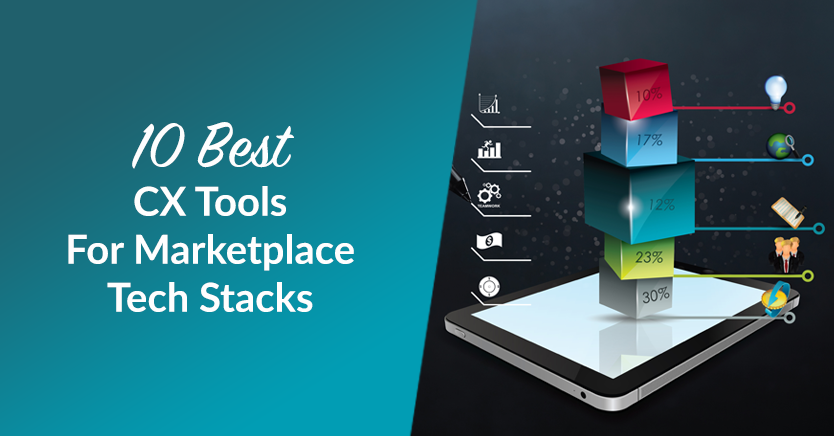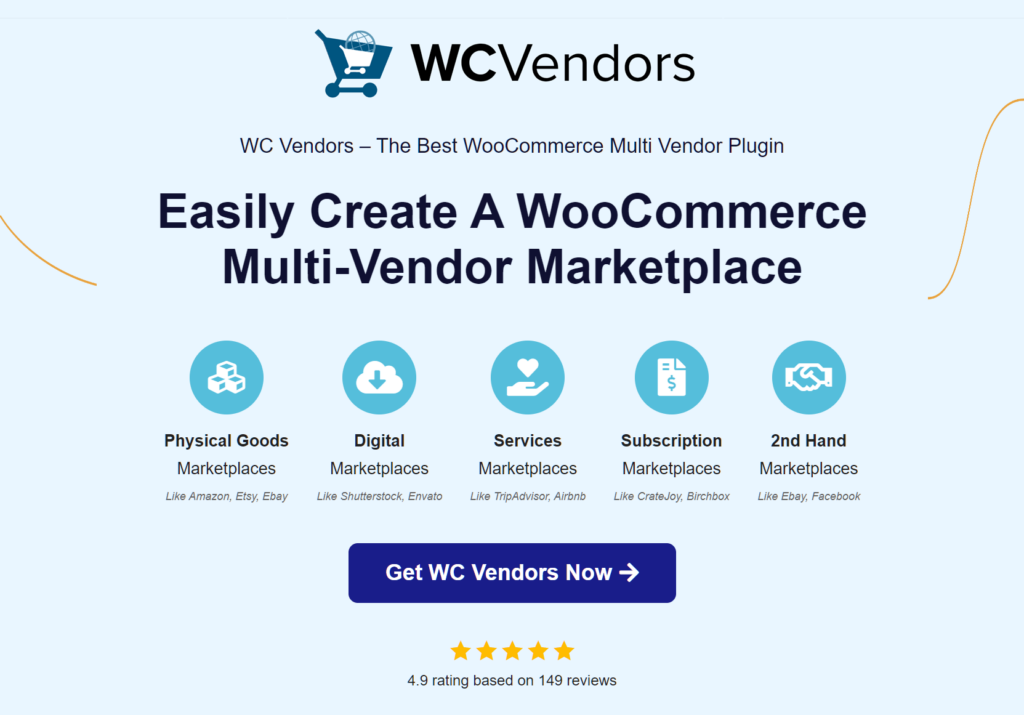
Are you considering launching an online marketplace? Or are you already running one? Whatever the case may be, you need customer experience tools, or CX tools for short, to boost your platform’s profitability.
Customer experience has become a difference-maker for online marketplaces. Brands have the opportunity to impress buyers at various parts of their customer journey to create lasting impressions. On the other end, poor online experiences can lead to high churn rates and a bad reputation for your marketplace.
We’ve covered some of the best practices for customer experience in a previous post. However, we also know that there’s another major contributor to success: the technology you use.
Top-performing multi-vendor marketplaces use sophisticated tech stacks to improve processes and optimize workflows for different operational needs. Customer experience is no different. For this reason, we’ve identified the top 10 best types of CX tools that empower online marketplaces to delight their buyers.
So let’s get right into it!
1. Customer Feedback Tools
Who can better speak to your customer experiences than the customers themselves?
Positive feedback can help you identify best practices while negative responses will give you actionable insight into where you can improve.
The best way to gather customer feedback is to ask your customers questions. Thankfully, there are several easy and effective ways to do this:
- Send out targeted surveys with detailed questions
- Use online polls for quick responses
- Have customers fill out questionnaires or forms at different parts of the customer journey
Top tools for customer feedback
- Qualtrics
- Survey Monkey
- Typeform

2. Customer Relationship Management (CRM) Software
The best CRM software brings a host of benefits to any online marketplace. Small wonder these CX tools have become the backbone of online business tech stacks.
Simply put, CRMs consolidate all your customer data into a dedicated space. You can use the platform to create customer profiles, access and manage contact information, track interactions, set reminders for further customer engagement, and do pretty much anything else involving the fostering of relationships.
All this information can inform your customer experience efforts as it gives you complete visibility over all of your customer data.
Popular CRM tools
- Salesforce
- Hubspot
- Monday.com
- Zoho

3. Social Media Channels
Social media seems to show up on pretty much any tech stack list. With so much versatility, it can meet a variety of needs.
While we usually associate social media with marketing, it can also help marketplaces improve their customer experience.
For starters, more and more e-commerce brands are choosing to sell directly through their social media channels. 2021 saw nearly one-third of e-commerce companies in the US and Europe selling through these channels. Meanwhile, 12% said they plan on eventually using social media.
Beyond the sales opportunity, many consumers, especially younger buyers, use social media to engage with brands. 75% of Gen Z consumers say social media ads influence their purchasing decisions.
So what does all this mean for customer experience?
It means social media provides you with a great opportunity to engage with and hear from your customers. Shoppers expect you to meet them where they are, and they’re on social media.
Best social media apps for marketplaces

4. Customer Journey Mapping
Having a well-thought-through customer journey is a critical part of the customer experience. You want to have something that engages potential buyers at any stage. One way to make this happen is by using customer journey mapping software.
These CX tools take the abstract idea of the journey and make it concrete. It’s like a coach’s whiteboard where they draw out the plays for the players to better understand and execute.
CX tools like Lucid Chart or Churn Zero make it easy to create diagrams that empower your team to:
- Visualize your entire customer journey from first impressions to conversion and beyond
- Understand customer expectations and objectives for each interaction
- Identify gaps in different customer touchpoints

5. Customer Experience Management Software
For a long time, companies would rope customer experience in with other departments like customer support or account management. With the discipline’s continued rise, however, brands have started looking for specific solutions.
This is where CX tools that specifically focus on customer experience management come in.
Customer experience management tools function much like CRM tools. However, they lean towards monitoring experiences and enhancing engagements. Many include a scoring system for moments and touchpoints so that teams can identify improvement areas.
Popular customer experience tools
- Active Campaign
- Intercom
- Guide CX

6. Helpdesk And Support
There’s quite a Venn diagram-like overlap between customer experience and support. While the two have their differences, they work together really well.
CX tools have helped support teams improve their service for years. Research shows that customers want:
- Fast service
- Consistency
- Personal engagement with knowledgeable staff
- Ease of use
- Various contact points
Having software platforms in place can enable customer service teams to succeed in all these areas.
Top helpdesk and support applications
- Zendesk
- Freshdesk
- Helpscout

7. Post-Purchase Communication Programs
Your customer experience shouldn’t end immediately after checkout. Marketplaces have a unique opportunity to follow up with customers when they’re still riding the high that comes from making a purchase.
A simple and cost-effective solution is to send e-receipts or thank-you notes. 45% of consumers want to receive digital receipts. 64% say they’re open to receiving other pieces of content. You can use such strategies for:
- Cross-selling promotions
- Links to how-to content for the item they’ve purchased
- Soliciting reviews
- Feedback on their customer experience
- Offer delivery tracking
Using CX tools that incorporate these pieces into your customer experience strategy will let you better serve and connect with your customers.
Best post-purchase communication tools
- Klaviyo
- Okendo
- Malomo
8. Return Management Applications
You’d think returns are a sign of a bad experience, right? Something went wrong, so customers sent their products back.
However, by offering a better return experience, marketplaces can turn something negative into a positive.
Better return processes have been linked to:
- A greater sense of loyalty
- More return buyers and second purchases
- Increased customer lifetime value
- Improved customer satisfaction
As with all other elements of online shopping, customers want their returns to be fast and easy, and the more you grant them this convenience, the happier they’ll be. Thankfully, CX tools such as return management software streamline the return process.
Best return management solutions for marketplaces
- Returnly
- Loop Returns
- Return Logic
9. Behavioral Analysis And Heatmaps
Few things will improve your customer experience efforts like knowing how your buyers engage with your digital products.
Visualizing, analyzing, and predicting customer behavior will allow your company to better understand what your customers experience on your website. Some save the interaction with visitor session recordings, too.
Relevant CX tools offer valuable customer insights like:
- How customers move their mouse across the page
- Where customers click
- How long customers spend in certain areas
- How far customers scroll on different pages
Once you’ve seen these real-time interactions, you’ll be able to identify areas of improvement and come up with more informed decisions.
Measure customer behavior with these tools
- Microsoft Clarity (Free!)
- Hotjar
- Mouseflow

10. Analytics For Customer Experience
All the CX tools we’ve mentioned are only valuable when they help your business provide better customer experiences. And “better” is a suggestive term if you don’t know how to measure it.
That’s where advanced analytics come in.
Marketplaces need a dashboard where they can visualize all their data in one place and measure their success.
Tools that offer the best marketplace metrics for different needs
For measuring specific aspects of your website like traffic, bounce rates, unique visitors, and other customer experience numbers, there’s nothing better than Google Analytics. This consistently stands out among similar CX tools for a reason.
More specific marketplace features will need something nuanced. That’s why WC Vendors is equipped with a sophisticated dashboard that lets you know if your customers enjoy engaging with your marketplace.
Conclusion
Successful marketplaces help their customers succeed on their platforms. Fortunately, by improving the shopping experience, you’ll inevitably improve customer loyalty, customer satisfaction, and customer growth in your marketplace, too.
To summarize, the following CX tools can effectively improve customer experience:
- Customer feedback tools
- Customer relationship management (CRM) software
- Social media channels
- Customer journey mapping
- Customer experience management software
- Helpdesk and support
- Post-purchase communication programs
- Return management applications
- Behavioral analysis and heatmaps
- Analytics for customer experience
Do you have any questions about CX tools? Reach out to us and let us know; we’d be glad to help you out!
